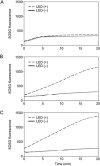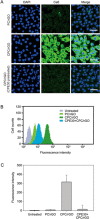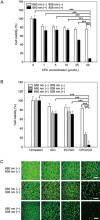Claudin 4-targeted nanographene phototherapy using a Clostridium perfringens enterotoxin peptide-photosensitizer conjugate
- PMID: 28552914
- PMCID: PMC5520197
- DOI: 10.1038/aps.2017.46
Claudin 4-targeted nanographene phototherapy using a Clostridium perfringens enterotoxin peptide-photosensitizer conjugate
Abstract
In this study we designed a claudin 4-directed dual photodynamic and photothermal system, in which a 30-amino acid claudin 4-binding peptide, Clostridium perfringens enterotoxin (CPE), was linked to a photodynamic agent chlorin e6 (Ce6) through a polyethylene glycol spacer (CPC) and anchored onto reduced graphene oxide (rGO) nanosheets to form CPC/rGO nanosheets. For comparison, a conjugate of polyethylene glycol and Ce6 (PC) was anchored onto the rGO nanosheets to generate PC/rGO. Both PC and CPC generated reactive oxygen species upon irradiation at 660 nm. Application of CPC/rGO to claudin 4-overexpressing U87 glioblastoma cells in vitro resulted in a significantly higher cellular uptake compared to application of PC/rGO. Upon irradiation at 660 and 808 nm, the CPC/rGO-treated U87 cells generated significantly higher reactive oxygen species and caused significantly higher temperature increase, and showed most potent anticancer effect compared to the other groups. Taken together, these results suggest that CPC/rGO is potentially useful as a tumor-specific combined phototherapy.
Figures








Similar articles
-
Co-Immobilization of Ce6 Sono/Photosensitizer and Protonated Graphitic Carbon Nitride on PCL/Gelation Fibrous Scaffolds for Combined Sono-Photodynamic Cancer Therapy.ACS Appl Mater Interfaces. 2020 Sep 9;12(36):40728-40739. doi: 10.1021/acsami.0c08446. Epub 2020 Aug 28. ACS Appl Mater Interfaces. 2020. PMID: 32794726
-
Safety and tumor tissue accumulation of pegylated graphene oxide nanosheets for co-delivery of anticancer drug and photosensitizer.Biomaterials. 2013 Apr;34(13):3402-10. doi: 10.1016/j.biomaterials.2013.01.010. Epub 2013 Feb 4. Biomaterials. 2013. PMID: 23380350
-
Development of chlorin e6-conjugated poly(ethylene glycol)-poly(d,l-lactide) nanoparticles for photodynamic therapy.Nanomedicine (Lond). 2019 Apr;14(7):819-834. doi: 10.2217/nnm-2018-0255. Epub 2019 Mar 15. Nanomedicine (Lond). 2019. PMID: 30874479
-
Targeted cancer phototherapy using phthalocyanine-anticancer drug conjugates.Dalton Trans. 2022 Sep 13;51(35):13157-13175. doi: 10.1039/d2dt02040h. Dalton Trans. 2022. PMID: 36018269 Review.
-
Gold-Based Nanoparticles Systems in Phototherapy - Current Strategies.Curr Med Chem. 2018;25(42):5914-5929. doi: 10.2174/0929867325666181031120757. Curr Med Chem. 2018. PMID: 30378476 Review.
Cited by
-
Targeting claudins in cancer: diagnosis, prognosis and therapy.Am J Cancer Res. 2021 Jul 15;11(7):3406-3424. eCollection 2021. Am J Cancer Res. 2021. PMID: 34354852 Free PMC article. Review.
-
Learning from Nature: Bioinspired Chlorin-Based Photosensitizers Immobilized on Carbon Materials for Combined Photodynamic and Photothermal Therapy.Biomimetics (Basel). 2020 Oct 14;5(4):53. doi: 10.3390/biomimetics5040053. Biomimetics (Basel). 2020. PMID: 33066431 Free PMC article. Review.
-
Endoplasmic Reticulum-Targeted Phototherapy Remodels the Tumor Immunopeptidome to Enhance Immunogenic Cell Death and Adaptive Anti-Tumor Immunity.Pharmaceuticals (Basel). 2025 Mar 28;18(4):491. doi: 10.3390/ph18040491. Pharmaceuticals (Basel). 2025. PMID: 40283929 Free PMC article.
-
Cryo-EM structures of Clostridium perfringens enterotoxin bound to its human receptor, claudin-4.Structure. 2024 Nov 7;32(11):1936-1951.e5. doi: 10.1016/j.str.2024.09.015. Epub 2024 Oct 8. Structure. 2024. PMID: 39383874
-
Structural and biophysical insights into targeting of claudin-4 by a synthetic antibody fragment.Commun Biol. 2024 Jun 17;7(1):733. doi: 10.1038/s42003-024-06437-6. Commun Biol. 2024. PMID: 38886509 Free PMC article.
References
-
- Zhang Z, Wang J, Chen C. Near-infrared light-mediated nanoplatforms for cancer thermo-chemotherapy and optical imaging. Adv Mater 2013; 25: 869–80. - PubMed
-
- Idris NM, Gnanasammandhan MK, Zhang J, Ho PC, Mahendran R, Zhang Y. In vivo photodynamic therapy using upconversion nanoparticles as remote-controlled nanotransducers. Nat Med 2012; 18: 1580–5. - PubMed
-
- Miao W, Shim G, Kim G, Lee S, Lee HJ, Kim YB, et al. Image-guided synergistic photothermal therapy using photoresponsive imaging agent-loaded graphene-based nanosheets. J Control Release 2015; 10: 28–36. - PubMed
MeSH terms
Substances
LinkOut - more resources
Full Text Sources
Other Literature Sources
Research Materials
Miscellaneous

